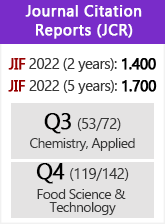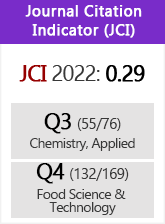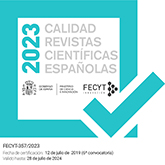The oleic acid esterification of policosanol increases its bioavailability and hypocholesterolemic action in rats
DOI:
https://doi.org/10.3989/gya.010612Keywords:
Bioavailability, Cholesterol lowering effect, Octacosanol, Policosanol, Policosanol absorption, Rats, TriacontanolAbstract
Policosanol comprises a mixture of long-chain aliphatic alcohols from sugarcane wax. More than 50 studies indicate that policosanol decreases serum cholesterol, while others failed to reproduce this effect. The objective of this investigation was to assess the bioavailability of esterified policosanol and non-esterified policosanol (NEP), in relation to their hypocholesterolemic effects. Sprague Dawley rats were given a daily oral dose of 100 mg/kg of NEP, 117 mg kg–1 of butyric acid esterified policosanol (BAEP), or 164 mg kg–1 of oleic acid esterified policosanol (OAEP). Policosanol absorption was evaluated in plasma between 0 and 3 hours after ingestion. To assess changes in total cholesterol, LDL-cholesterol, HDLcholesterol and triacylglycerols in plasma and liver 3-hydroxy- 3-methylglutaryl coenzyme A reductase (HMG- CoA red) phosphorylation, the rats were supplemented with nonesterified or esterified policosanol for 5 weeks. The results indicate that policosanol absorption was significantly greater in OAEP-treated rats than in those subjected to NEP or BAEP administration. OAEP significantly reduced plasma total and LDL-cholesterol in rats, in addition to a 5.6-fold increase (P < 0.05) in the hepatic content of phosphorylated HMG-CoA red over the control values. In conclusion, esterification of policosanol with oleic acid enhances policosanol bioavailability, and significantly improves the serum lipid profile in normocholesterolemic rats in association with the inactivation of HMG-CoA red controlling cholesterogenesis.
Downloads
References
Arruzazabala ML, Noa M, Menéndez R, Mas R, Carbajal D, Valdes S, Molina V. 2000. Protective effect of policosanol on atherosclerotic lesions in rabbits with exogenous hypercholesterolemia. Braz. J. Med. Biol. Res. 33, 835-840. http://dx.doi.org/10.1590/S0100-879X2000000700015 PMid:10881060
Batista J, Stusser R, Saez F, Pérez B. 1996. Effect of policosanol on hyperlipidemia and coronary heart disease in middle-aged patients. A 14-month pilot study. Int. J. Clin. Pharmacol. Ther. 34, 134-137. PMid:8705091
Berthold H, Unverdoeben S, Degenhardt R, Bulitta M, Gouni-Berthold I. 2006. Effect of lipids policosanol on lipid levels among with hypercholesterolemia or combined hyperlipidemia. JAMA. 295, 2262-2269. http://dx.doi.org/10.1001/jama.295.19.2262 PMid:16705107
Brockerhoff H. 1970. Substrate specificity of pancreatic lipase: Influence of the structure of fatty acids on the reactivity of esters. Biochim. Biophys. Acta. 212, 92-101. http://dx.doi.org/10.1016/0005-2744(70)90181-6
Buhman KK, Accad M, Novak S, Choi RS, Wong JS, Hamilton RL, Turley S, Farese RV Jr. 2000. Resistance to diet-induced hypercholesterolemia and gallstone formation in ACAT2-deficient mice. Nat. Med. 6, 1341-1347. http://dx.doi.org/10.1038/82153 PMid:11100118
Castaño G, Mas R, Arruzazabala ML, Noa M, Illnait J,Fernandez JC, Molina V, Menendez A. 1999. Effects of policosanol and pravastatin on lipid profile, platelet aggregation and endothelemia in older hypercholesterolemic patients. Int. J. Clin. Pharm. Res. 19, 105-116. PMid:10939028
Castaño G, Mas R, Fernández L, Fernández JC, Illnait J, López LE, Alvarez E. 2000. Effects of policosanol on postmenopausal women with type II hypercholesterolemia. Gynecol. Endocrinol. 14, 187-195. http://dx.doi.org/10.3109/09513590009167681 PMid:10923280
Castaño G, Mas R, Fernández L, Illnait J, Gámez R, Alvarez E. 2001. Effects of policosanol 20 versus 40 mg/day in the treatment of patients with type II hypercholesterolemia: a 6-month double-blind study. Int. J. Clin. Pharmacol. Res. 21, 43-57. PMid:11708574
Castaño G, Mas R, Fernández L, Illnait J, López E, Gamez R, Mendoza S, Fernández J, Mesa M. 2003. Effects of D-003 on the lipid profile of patients with type II hypercholesterolemia: a phase II clinical study. Clin. Drug Investig. 23, 789-802. PMid:17536893
Choudhury N, Tan L, Truswell AS. 1995. Comparison of palmolein and olive oil: effects on plasma lipids and vitamin E in young adults. Am. J. Clin. Nutr. 61, 1043-1051. PMid:7733026
Clifton P. 2009. Lowering cholesterol - a review on the role of plant sterols. Aust. Fam. Physician 38, 218-221. PMid:19350071
Crespo N, Illnait J, Mas R, Fernández L, Fernández JC, Castaño G. 1999. Comparative study of the efficacy and tolerability of policosanol and lovastatin in patients with hypercholesterolemia and noninsulin dependent diabetes mellitus. Int. J. Clin. Pharmacol. Res. 29, 117-127.
Dulin M, Hatcher L, Sasse H, Barringer T. 2006. Policosanol is ineffective in the treatment of hypercholesterolemia: a randomized controlled. Am. J. Clin. Nutr. 84, 1543–1548. PMid:17158441
Francini-Pesenti F, Brocadello F, Beltramolli D, Nardi M, Caregaro L. 2008a. Sugar cane policosanol failed to lower plasma cholesterol in primitive, diet-resistant hypercholesterolaemia: a double blind, controlled study. Complement Ther. Med. 16, 61-65. http://dx.doi.org/10.1016/j.ctim.2007.08.003 PMid:18514906
Francini-Pesenti F, Beltramolli D, Dall'acqua S, Brocadello F. 2008b. Effect of sugar cane policosanol on lipid profile in primary hypercholesterolemia. Phytother. Res. 22, 318-322. http://dx.doi.org/10.1002/ptr.2315 PMid:18167048
González-Bravo L, Magraner-Hernández J, Acosta-Gonzalez PC, Pérez-Souto N. 1996. Analytical procedure for the determination of 1-octacosanol in plasma by solvent extraction and capillary gas chromatography. J. Chromatogr. B Biomed. Appl. 682, 359-363. http://dx.doi.org/10.1016/0378-4347(95)00515-3
Gouni-Berthold I, Berthold HK. 2002. Policosanol: clinical pharmacology and therapeutic significance of a new lipid-lowering agent. Am. Heart J. 143, 356-365. http://dx.doi.org/10.1067/mhj.2002.119997 PMid:11835043
Greyling A, DeWitt C, Oosthuizen W, Jerling J. 2006. Effects of a policosanol supplement on serum lipid concentrations in hypercholesterolemic and heterozygous familial hypercholesterolemic subjects. Br. J. Nutr. 95, 968–975. http://dx.doi.org/10.1079/BJN20061715 PMid:16611388
Haim D, Berrios M, Valenzuela A, Videla L. 2009. Trace quantification of 1-octacosanol and 1-triacontanol and their main metabolites in plasma by liquid-liquid extraction coupled with gas chromatography mass spectrometry. J. Chromatogr. B. Biomed. Appl. 887, 4154-4158.
Haim D, Videla L. 2008. Policosanols, protective natural compounds in cardiovascular disease. Agro Food Industry Hi-Tech. 19, 60-63.
Hargrove JL, Greenspan P, Hartle DK. 2004. Nutritional significance and metabolism of very long chain fatty alcohols and acids from dietary waxes. Exp. Biol. Med. 229, 215-226.
Hayes KC, Khosla P. 1992. Dietary fatty acid thresholds and cholesterolemia. FASEB J6, 2600-2607. PMid:1592210
Hernandez F, Illnait J, Mas R. 1992. Effect of policosanol on serum lipid and lipoproteins in healthy volunteers. Curr. Ther. Res. Clin. Exp. 51, 568-575.
Janikula M. 2002. Policosanol: a new treatment for cardiovascular disease? Altern. Med. Rev. 7, 203-217. PMid:12126462
Kabir Y, Kimura S. 1993. Biodistribution and metabolism of orally administered octacosanol in rats. Ann. Nutr. Metab. 37, 33-38. http://dx.doi.org/10.1159/000177746 PMid:8470870
Kassis AN, Jones PJ. 2006. Lack of cholesterol-lowering efficacy of Cuban sugar cane policosanols in hypercholesterolemic persons. Am. J. Clin. Nutr. 84, 1003-1008. PMid:17093150
Kassis AN, Marinangeli CP, Jain D, Ebine N, Jones PJ. 2007. Lack of effect of sugar cane policosanol on plasma cholesterol in Golden Syrian hamsters. Atherosclerosis 194, 153-158. http://dx.doi.org/10.1016/j.atherosclerosis.2006.10.008 PMid:17123537
Keller S, Gimmler F. 2008. Octacosanol administration to humans decreases neutral sterol and bile acid concentration in feces. Lipids. 43, 109-115. http://dx.doi.org/10.1007/s11745-007-3127-4 PMid:18004604
Laemmli UK. 1970. Cleavage of structural proteins during the assembly of the head of bacteriophage T4. Nature. 227, 680-685. http://dx.doi.org/10.1038/227680a0 PMid:5432063
Marrero D, González-Bravo L. 2001. Trace determination of 1-octacosanol in rat plasma by solid-phase extraction with Tenax GC and capillary gas chromatography. J. Chromatogr B. Biomed. Appl. 762, 43-49. http://dx.doi.org/10.1016/S0378-4347(01)00331-0
Mas R, Castaño G, Illnait J, Fernandez L, Fernandez J, Aleman C, Pontigas V, Lescay M. 1999. Effects of policosanol in patients with type II hypercholesterolemia and additional coronary risk factors. Clin. Pharmacol. Ther. 65, 439-447. http://dx.doi.org/10.1016/S0009-9236(99)70139-6
Mendoza S, Gamez R, Noa M, Mas R, Castaño G, Mesa R, Mesa MS, Armas M. 2001. Comparison of the effects of D-003 and policosanol on lipid profile and endothelial cells in normocholesterolemic rabbits. Curr. Ther. Res. 62, 209-220. http://dx.doi.org/10.1016/S0011-393X(01)80032-1
Menendez R, Amor AM, Gonzalez RM, Fraga V, Mas R. 1996. Effect of policosanol on the hepatic cholesterol biosynthesis of normocholesterolemic rats. Biol. Res. 29, 253-257. PMid:9278716
Menéndez R, Amor AM, Rodeiro I, González RM, Gonzalez PC, Alfonso JL, Mas R. 2001. Policosanol modulates HMG-CoA reductase activity in cultured fibroblasts. Arch. Med. Res. 31, 8-12. http://dx.doi.org/10.1016/S0188-4409(00)00265-4
Menéndez R, Marrero D, Más R, Fernández I, González L, González RM. 2005. In vitro and in vivo study of octacosanol metabolism. Arch. Med. Res. 36, 113–119. http://dx.doi.org/10.1016/j.arcmed.2004.12.006 PMid:15847942
Murphy KJ, Saint DA, Howe PR. 2008. Lack of effect of sugar cane and sunflower seed policosanols on plasma cholesterol in rabbits. J. Am. Coll. Nutr. 27, 476-484. PMid:18978167
Ng TK, Hayes KC, DeWitt GF, Jegathesan M, Satgunasingam N, Ong AS, Tan D. 1992. Dietary palmitic acid and oleic acid exert similar effects on serum cholesterol and lipoprotein profiles in normocholesterolemic men and women. J. Am. Coll. Nutr. 11, 383-390. PMid:1506599
Ng Chi H, Leung Ka Y, Huan Y, Cehn Zhen Y. 2005. Policosanol has no antioxidant activity in human lowdensity lipoprotein but increases excretion of bile acids in hamsters. J. Agric. Food Chem. 53, 6289-6293. http://dx.doi.org/10.1021/jf051269a PMid:16076108
Nissinen MJ, Gylling H, Miettinen TA. 2006. Effects of plant stanol esters supplied in a fat free milieu by pastilles on cholesterol metabolism in colectomized human subjects. Nutr. Metab. Cardiovasc. Dis. 16, 426-435. http://dx.doi.org/10.1016/j.numecd.2005.07.005 PMid:16935701
Oliaro-Bosso S, Calcio Gaudino E, Mantegna S, Giraudo E, Meda C, Viola F, Cravotto G. 2009. Regulation of HMG-CoA reductase activity by policosanol and octacosadienol, a new synthetic analogue of octacosanol. Lipids. 44, 907-916. http://dx.doi.org/10.1007/s11745-009-3338-y PMid:19763655
Place AR. 1992. Comparative aspects of lipid digestion and absorption: physiological correlates of wax ester digestion. Am. J. Physiol. 263, R464–R471. PMid:1415629
Pons P, Mas R, Illnait J, Fernandez L, Rodriguez M, Robaina C, Fernández JC. 1992. Efficacy and safety of policosanol in patients with primary hypercholesterolemia. Curr. Ther. Res. Clin. Exp. 52, 507-513. http://dx.doi.org/10.1016/S0011-393X(05)80456-4
Prat H, Roman O, Pino E. 1999. Comparative effects of policosanol and two HMG-CoA reductase inhibitors on type II hypercholesterolemia. Rev. Med. Chile 127, 286-294. PMid:10436712
Sánchez-Muniz FJ, Cruz-Merinero M, Rodríguez-Gil S, Ordovás JM, Ródenas S, Cuesta C. 2002. Dietary fat saturation affects apolipoprotein AII levels and HDL composition in postmenopausal women. J. Nutr. 132, 50-54. PMid:11773507
Singh BK, Mehta JL. 2002. Management of dyslipidemia in the primary prevention of coronary heart disease. Curr. Opin. Cardiol. 17, 503-511. http://dx.doi.org/10.1097/00001573-200209000-00010 PMid:12357127
Singh D, Li L, Porter T. 2006. Policosanol inhibits cholesterol synthesis in hepatoma cells by activation of AMP kinase. J. Pharm. Exp. Therap. 318, 1020-1026. http://dx.doi.org/10.1124/jpet.106.107144 PMid:16714400
Torres O, Agramonte AJ, Más R, Fernández L, Fernández JC. 1995. Treatment of hypercholesterolemia in NIDDM with policosanol. Diabetes Care. 18, 393–397. http://dx.doi.org/10.2337/diacare.18.3.393 PMid:7555484
Towbin H, Staehelin T, Gordon J. 1979. Electrophoretic transfer of proteins from polyacrylamide gels to nitrocellulose sheets: procedure and some applications. Proc. Natl. Acad. Sci. USA. 76, 4350-4354. http://dx.doi.org/10.1073/pnas.76.9.4350 PMid:388439 PMCid:411572
Wong AK, Howie J, Petrie JR, Lang CC. 2009. AMPactivated protein kinase pathway: a potential therapeutic target in cardiometabolic disease. Clin. Sci. 16, 607-620. http://dx.doi.org/10.1042/CS20080066 PMid:19275766 PMCid:2762688
Wu T, Fu J, Yang Y, Zhang L, Han J. 2009. The effects of phytosterols/stanols on blood lipid profiles: a systematic review with meta-analysis. Asia Pac. J. Clin. Nutr. 18, 179-186. PMid:19713176
Downloads
Published
How to Cite
Issue
Section
License
Copyright (c) 2012 Consejo Superior de Investigaciones Científicas (CSIC)

This work is licensed under a Creative Commons Attribution 4.0 International License.
© CSIC. Manuscripts published in both the printed and online versions of this Journal are the property of Consejo Superior de Investigaciones Científicas, and quoting this source is a requirement for any partial or full reproduction.All contents of this electronic edition, except where otherwise noted, are distributed under a “Creative Commons Attribution 4.0 International” (CC BY 4.0) License. You may read here the basic information and the legal text of the license. The indication of the CC BY 4.0 License must be expressly stated in this way when necessary.
Self-archiving in repositories, personal webpages or similar, of any version other than the published by the Editor, is not allowed.
















